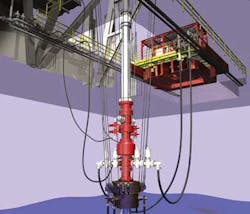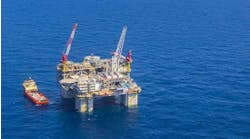Essam Sammat
Weatherford
Prolific deepwater frontiers hold a wealth of opportunity for oil and gas recovery. But as E&P companies ramp up drilling activity in these promising fields, they are encountering challenges that drive up costs, non-productive time, and risk. Inherently unstable wellbores prone to pore-pressure changes and the possibility of the well to pack-off in often remote reservoirs are among the issues.
West Africa is an important deepwater market where high drilling costs are ushering in advanced methods, such as managed pressure drilling (MPD), that are changing the way wells are drilled. MPD, the technique of maintaining and controlling bottomhole pressure using surface equipment, has been a game-changer in the industry's ability to access deepwater and ultra-deepwater reservoirs. These environments typically present narrow drilling windows, caused by the combined pressure of the water and sediment.
MPD technology, which can be deployed from semisubmersible rigs and drillships, facilitates the monitoring of downhole conditions much more precisely than conventional equipment. By detecting influxes early, MPD systems help offshore operators prevent dangerous and costly well control events or well shut-in.
An MPD system, used in conjunction with a continuous circulating device to control wellbore pressure, helped an international E&P company successfully drill a difficult section of an exploratory deepwater well in Ghana, West Africa, in 2012. The two-month project, which involved extensive pre-job planning, enabled the operator to achieve well objectives, drill deeper than planned, and save considerable cost and time.
The decision to deploy MPD in this case followed an unsuccessful 2008 drilling campaign in a nearby offset well that presented an unstable zone and sharp changes in pore pressures. While drilling the 12¼-in. section, the operator observed constant blocky shale cuttings at the surface, later determined to be the result of a rubble zone in the section.
The conventionally drilled well packed off several times as the shale sloughed around the bottomhole assembly (BHA), preventing circulation. After each pack-off event, the BHA had to be pulled up to where the wellbore was consistently stable. The operator eventually decided to plug the main wellbore and drill a side track to penetrate the rubble zone from a distance, using a higher mud weight to prevent the unstable zone from sloughing.
The side track encountered less resistance and sloughing until a significant drilling break occurred. Both the main wellbore and the side track became permanently plugged, preventing the operator from reaching target depth. The well, which encountered a gas/water influx of 16-20 bbl, leading to shut-in, was permanently abandoned at the 12¼-in. section.
The exploratory well, located 1,312 ft (400 m) from the offset well in water depth of 5,500 ft (1,675 m) and 65 nautical miles (75 miles) from shore, was to obtain full reservoir evaluation to determine the commercial viability of the well. Based on the difficulties in the offset well, the operator and service company Weatherford implemented the MicroFlux MPD Control System, a closed-loop system that enables accurate detection and effective management of minute fluid influxes in challenging wellbores. An auto-control feature applies corrective actions to restore mass balance and provide faster response times.
MPD installed
The MPD operation was deployed from the deepwater semisubmersible rigTransocean Marianas. The well design dictated that the MPD system would be positioned at the top of the marine riser, which included a rotating control device (RCD) and an MPD choke manifold system so the drilling operation could be conducted with surface pressure. The choke manifold also serves as an advanced kick detection system. A real-time flow meter, installed downstream of the choke, detects smaller influx volumes compared to conventional equipment. By detecting kicks early and minimizing the size of the kick, the system enhances operational safety.
A key enabler for any MPD system, whether on land or offshore, is the RCD, used in a mud-return system to contain annular fluids while drilling. On floating rigs, an RCD can be installed either below or above the tension ring configuration, a decision often dictated by weather and sea conditions. It is important that the RCD remain static on the riser so that any rig movement does not cause pressure changes in the wellbore annulus, which may result in inaccurate flow measurement by the MPD system and make detection of kicks, losses, and ballooning considerably more difficult.
Installing the device below the tension ring configuration allows the rig to maintain use of the existing telescopic riser joint, or slip joint, to achieve maximum stroke and compensate for rig movement in harsher sea conditions. Installing the RCD above the tension ring configuration prevents the main rig telescopic joint from being used, therefore requiring a shorter telescopic joint above the RCD to compensate for rig movement or heaving.
In this case, because sea conditions in the region are calm, the SeaShield RCD was installed above the tension ring configuration to create a closed-loop system whereby the active returns flow could be diverted below the RCD and avoid the rig's conventional return flowline. A telescopic joint was retained to optimize alignment of the rig/drill pipe with the RCD/riser, reducing excessive wearing of the RCD element.
Additional equipment installed in the riser below the RCD included an annular preventer, or riser annular, and a flow spool, which enables the RCD sealing elements to be changed while circulation keeps pressure on the well. The riser annular eliminates the need to use and strip drill pipe through the rig's subsea annular preventer. When the RCD sealing elements need replacing, the riser annular closes around the drill pipe, sealing the annulus pressure below the RCD.
For this operation, the addition of the circulation system enabled continuous downhole circulation while making up or breaking out drill pipe connections. The circulating device is a dual-valve sub made up in the drillstring to allow continuous circulation of the drilling fluid into the well for improved performance. Constant circulation during drill pipe connection maintains the downhole cooling effect on the BHA element, extending the life of the electronics. Downhole parameters, such as equivalent circulating density (ECD), temperature, and tool status, also are continuously transmitted in real time. In the event of an emergency well control situation, where the integrity of the drillstring may be compromised, the circulating device sub also serves as a backpressure/check valve in the string, preventing uncontrolled flowback from the drill pipe.
Extensive planning, simulation
Pre-job planning and testing, including a rig survey to assess the practical aspects of installing and operating the MPD system, riser assembly, and RCD, proved critical to the success of the operation. Due to space constraints on the rig, a special platform to accommodate the MPD manifold was installed on the BOP cart in the moonpool, with the main flowlines from the flow spool connected to the manifold using hoses, isolation valves, and a custom buffer manifold. A high-capacity mud gas separator (MGS) was positioned on the lower pipe deck.
The two-part MPD riser assembly, including the RCD, was installed on top of the surface annular preventer in two parts: an upper sub-assembly, with a three-part slip joint and slip joint riser adapter, and a lower sub-assembly, with a riser adapter, flow spool, and the riser annular and RCD.
The operator, drilling contractor, and service company conducted a two-day hazardous operations exercise to assess what hazards might occur and the mitigation tools in place for addressing over-pressure, high temperature, and flow problems. The team studied two primary nodes – one from the drill bit to the surface via the annulus, the other from the buffer spool to the MGS and onto the rig choke and kill manifold. Procedures for testing pressure of the riser stack-up, third-party equipment installation, training requirements, and the RCD element change-out also were reviewed, along with kick matrix requirements.
An oil-based fluid, shown in deepwater well studies to be effective in keeping gas dissolved in solution, was selected. The slip joint/riser pressure limitation was increased to 1,000 psi (69 bar) to apply the required surface backpressure to compensate drilling friction losses without over-pressurizing the slip joint and riser assembly. This adjustment also provided a means to safely divert gas-bearing fluid away from the rig floor and toward the MPD choke manifold system.
The team performed hydraulic, temperature, and kick simulations to determine if influxes could be circulated out using the MPD system, or if the well would need to be shut in for conventional circulation. Transient simulations, by adjusting the conventional kick module of dynamic well control software for the MPD application, took into account the dissolution of gas in an oil-based mud. A well control matrix was developed to provide a clear protocol for dealing with various volumes of influx based on surface pressure:
- Green operating limit: normal state with no influx and surface backpressure less than 150 psi (10 bar), allowing operations to continue as planned
- Yellow limit: an influx of up to 5 bbl with a surface backpressure limit of less than 800 psi (55 bar), dictating drilling be stopped and the influx circulated out before resuming operations
- Red limit: influx of more than 5 bbl and backpressure of more than 800 psi, signaling that drilling be suspended and the well shut in using the subsea BOP, the last line of defense in an MPD well.
The well control plan also included procedures for circulating gas out of the riser if the BOP was closed and the well shut in. A decision tree was devised to identify the severity of an influx and the necessary response actions.
The MPD campaign was launched in February 2012, and achieved all well goals in two months. The 14¾-in. well was vertically drilled to a TD of 14,927 ft (4,550 m), 532 ft (162 m) deeper than the planned objective, allowing the 133⁄8-in. casing to be set lower and eliminating the need for the 105⁄8-in. section. Surface backpressure was applied during connections to keep the BHP from fluctuating and to control the annular pressure profile. The MPD system adjusted the surface backpressure to circulate out some minor water kicks (2 bbl), and also applied 170 psi (12 bar) to the wellbore while pulling out of hole to keep the well stable and free from swabbing influx.






